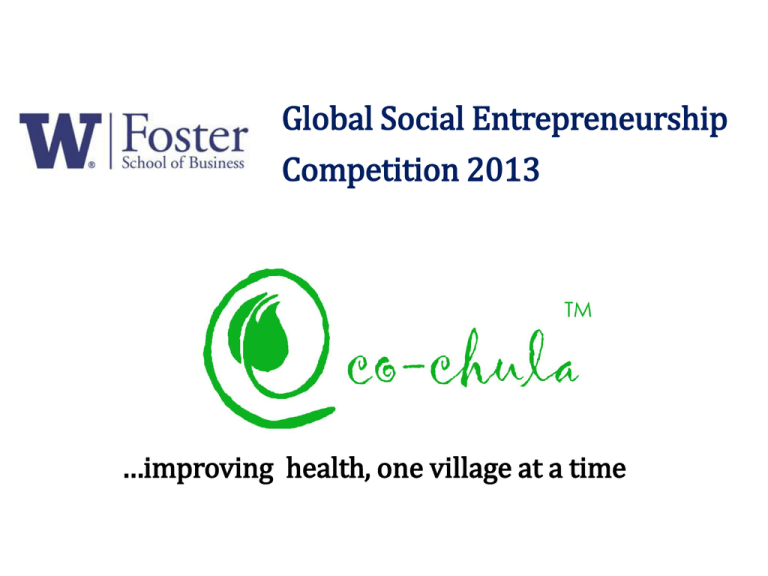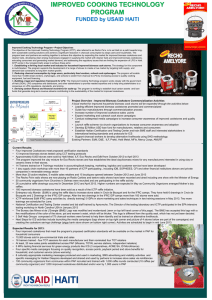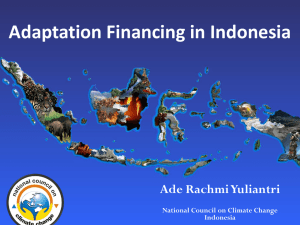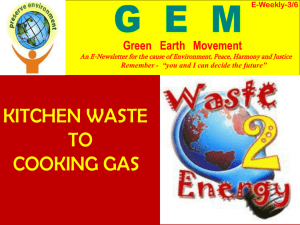EcoChula - Foster School of Business
advertisement

Global Social Entrepreneurship Competition 2013 …improving health, one village at a time Meet Asha Indoor Air Pollution- A Global Health Threat Afghanistan Liberia Congo Paraguay The Solution: Eco-Chula A self -sustaining energy system that combines an economic cook stove with locally derived cheap, renewable biogas fuel • Economical • • More efficient cooking Cleaner Air Business Model Bio-mass Refill Improving health with gas Distribution Bio gas Cook stove Why health has not improved Stove: High price and low efficiency Distribution: Fuel: -Not accessible -Not convenient -Uneducated people -Biomass -Wood -Kerosene -Dung Business Strategies 2014 2015 6 villages of Jamalpur Jamalpur District 375 Families 470,000+ families Improves: - health - environment Improves: - health - environment 2016 Adjacent districts of Jamalpur 3.3 M+ families Improves: -health -environment 2019 Bangladesh 20 M+ families Improves: - health - environment 2024 Global expansion 600 M+ families Improves: - health - environment Partnerships and Resources Management Team Shamroze Nurul Abedin CEO and Director of Public relations Organizations Global Alliance for Clean Cookstoves (GACC) Bangladesh Rural Advancement Committee (BRAC) Bangladesh Council for Scientific and Industrial Research (BCSIR) Engineers in Technical and Humanitarian Opportunities of Service (ETHOS) Tamanna Shahnowaz Sohanee CFO and Director of Sales Asif Iqbal Director of Productions and Operations and HR Advisors M.R. Khan (Professor, Respiratory Medicine and Public Health) Syed Manir Khasru (Finance, Professor, IBA, DU) Anwarul Kabir (Civil Engineer, WFP) Dr. Md. Abdur Rouf (Scientific Officer, BCSIR) Lameya Samin (Mechanical Engineer) Imran Nurul Abedin (MBA student) Pricing Strategy Price of 1 stove and 1 biogas cylinder • USD 15 Price of biogas • USD 0.11 per m3 Price Justification: • Biogas consumption cost- $36.96 • Lowest income households spend USD 37 or 15% Financials Initial capital requirement: $130,000 Discounted payback IRR 172% 2.16 years NPV $164,675 Social Return on Investment SROI $27.11 Medical cost savings- $78 M+ Increase value of environment- $64 M+ Increase income- $13 M+ Create a health database Change in quality of life Problem Respiratory illness and eye problems Improving air quality Vector borne diseases from untreated biomass Converting biomass into clean fuel Deaths caused smoke inhalation Reduces number of deaths Eco-Chula: ….improving health, one village at a time Positive Impact on Global Health Financial Sustainability Implementation Feasibility Positive Effect on Quality of Life Thank you (: Additional Information Slide 3: Global Threat Slide 4: The Solution Slide 5: Business Model Slide 6: Why health has not improved Slide 7: Business strategies Slide 8: Partnership and resources Slide 9: Pricing strategy and justification Slide 10: Financials Slide 11: SROI Slide 12: Changes in quality of life Slide 18: Assumptions Slide 31: Stove production cost Slide 19: Pro Forma Cash Flow Slide 32: Biogas production cost Slide 20: Pro Forma Balance Sheet Slide 33: Estimated market size & Market value breakdown Slide 21: Pro Forma Income Statement Slide 22: Investment Slide 34: Breakeven quantity & sensitivity analysis Slide 23: Assumptions Slide 35: Loan repayment schedule Slide 24: Reduction in medical spending Slide 36: Ability to serve client group Slide 25: Assumptions Slide 26: Increase in greener environment Slide 27: Assumptions Slide 28: Increase in productivity Slide 29: Discounted payback period Slide 30: Salary structure Slide 37: Analysis of stakeholder needs Slide 38: A comparison with competitors and barriers of entry Slide 39: Comparison of different stoves and layout of market research Discounted payback year 1 2 3 4 5 Discounted cash flow $ 19,578.30 $ 79,845.30 $ 87,667.75 $ 88,593.83 $ 90,357.77 Accumulated Payback dcf $ 19,578.30 $ $ 99,423.60 30,576.40 $ 0.16 187,091.35 $ 275,685.18 $ 366,042.95 discounted payback period in years 2.16 Salary Table No. of employees year 1 yea r2 year 3 year 4 year 5 Monthly USD 1 1 1 1 1 246 Purchase Officer x 1 Assembly Worker x 10 Security x 2 Total Biogas Plant Project Manager x 1 Plant Supervisor x 3 Security x 2 Day Labor x10 1 10 2 1 10 2 1 10 2 2 20 2 2 20 2 98 30 49 total 1 3 2 10 1 3 2 10 1 3 2 10 1 3 2 15 1 3 2 15 Warehouse workers BRAC health workers Driver 10 15 2 10 15 2 15 15 3 15 20 3 15 20 3 184 61 43 37 total 45 50 40 maintenance total Office CEO CFO and director od=f sales Dir, Production and Operation and HR Accountant 1 1 1 1 1 40 1 1 1 1 1 1 1 1 1 1 600 500 1 1 1 1 1 450 1 1 1 1 1 285 2758 Stove Factory Project Manager x 1 stove prod cost USD Plastic knob 0.1 PVC Pipe 0.1 Gun Metal Valve 0.5 Ceramic Stove Burner (2 piece) 2 Stainless Steel body 2 Gas Cylinder 7.8 total cost per unit 12.5 13.375 14.31125 15.3130375 16.38495 profit margin 20% 15 16.05 17.1735 18.375645 stove units Production cost USD 4500 56250 4950 66206.25 5445 77924.76 5989.5 91717.44 6588.45 107951.4247 19.66194 BIOGAS production cost Raw Materials 0.26 Production Cost per unit USD 0.26 0.28 0.30 0.32 0.34 0.36 Production (Units) 262800 289080 317988 349786.8 384765.48 423242.028 Total Production Cost $ 68,328.00 $80,422.06 $94,656.76 $ 111,411.01 $ $ 154,340.90 131,130.75 There are approx. 150 million people living in Bangladesh now of which 89% use TCS which creates a huge market of around USD 1.3 billion Total Population Users of TCS Average family size Number of target families Yearly consumption/family Total market value Industry Analysis 150,000,000 133,500,000 5 per family 26,700,000 $48.88 *$1.3 billion ICS Kerosene stoves Chimney stoves Eco-Chula Purchase of stove is a 1 time investment and 1 gas cylinder of 28m^3 can meet a family’s per month gas needs. Price of stove with a 28m^3 biogas cylinder= $15 Price of gas per m^3= $0.11 Price of gas consumption for the next 11 months= $0.11*28*11 = $33.88 Total yearly consumption per family= $15 + $33.88= $48.88 Total market value= $48.88*26700000= $1,305,096,000~$1.3 billion Fixed Cost Variable cost per unit SP/unit CM Break even quantity $ 127,500.00 $ 12.76 $ 15.00 $ 2.66 $ 47,932.33 $ 127,500.00 $ 13.66 $ 16.05 $ 2.54 $ 50,236.41 Case Base NPV($) 343,627.35 IRR 227% Best 471,543.41 335% Worst 259,657.02 155% $ 127,500.00 $ 14.61 $ 17.17 $ 3.03 $ 42,093.10 $ 127,500.00 $ 15.63 $ 18.37 $ 3.23 $ 39,473.68 $ 127,500.00 $ 16.72 $ 19.66 $ 3.46 $ 36,849.71 Project Year Loan Receipt 0 1 2 3 4 5 6 7 50,000 Balance Begin. Of Year 50,000 50,000 42,000 34,000 26,000 18,000 10,000 2,000 Interest Due Interest Payment Principal Repayment Total Payment Balance End of Year 7,750 6,510 5,270 4,030 2,790 1,550 310 7,750 6,510 5,270 4,030 2,790 1,550 310 8,000 8,000 8,000 8,000 8,000 8,000 2,000 15,750 14,510 13,270 12,030 10,790 9,550 2,310 78,210 50,000 42,000 34,000 26,000 18,000 10,000 2,000 Geo-political Social Economic As highly influential geo-political leaders such as union chairmen and mayors would benefit in future elections by supporting an ecofriendly product like Eco-Chula that creates employment opportunities for the local community, their support will help EcoChula in reaching its target markets effectively. As Bangladeshi people are disinterested in purchasing or continuing to use ICS, even if their health improves, a behavioral change campaign will be activated in order to educate them about ICS and its benefits. Eco-Chula creates employment opportunities, reduces IAP and improves the overall standard of living. A rise in living standards would ultimately imply an increase in demand for Eco-Chula and thereby, provide greater opportunities for Eco-Chula to make profits. Stakeholder Rural, peri-urban, urban dwellers Problem Unemployment/financial instability Health risks Women Disempowerment Health risks Children Illiteracy Health risks Overall economy Unstable economy Natural environment Deforestation, Greenhouse Effect Impact of Eco-Chula Employment for the people Elimination of IAP and IAP related diseases Work opportunity for women Prevention of IAP related diseases and harmful effects Time previously spent searching for biomass for cooking now spent at school Prevention of IAP related diseases and harmful effects Lower unemployment rate Improved standard of living Wood no longer used as fuel for cooking Zero carbon emission Factors Focus Offerings Grameen Shakti ICS Social business for welfare activity Biomass driven improved cookstoves Foreign and local NGO’S Eco-Chula Donations or charity Social business Run on donations to provide improved biomass- cookstoves Short term sustainability due to cost and fuel inefficiency An integrated, affordable solution Sustainability Short term sustainability due to use of biomass Long term sustainability due to cheap biogas resources Scope Available in villages for last 6 years Not widely available Expanding to other villages by 1 year Customer satisfaction Low Low High a) Intellectual Property Right: The intellectual property right will be protected by the entrepreneurs of the business by applying for patent of the brand name of Eco-Chula. b) Strong Partnership and Customer Relationship: Eco-Chula has already established an online partnership with Global Alliance for Clean Cookstoves (GACC), a global private public organization which provides clean cookstoves to a number of people in areas associated with high levels of poverty. Eco-Chula also plans to build ties with the people of Bangladesh in order to build strong customer equity through Bangladesh Rural Advancement Committee (BRAC) health workers. Factors Traditional cookstoves Improved cookstoves Eco-Chula Type of fuel Wood, kerosene, agricultural residues Biomass such as wood, Compressed biogas Cooking time Longer Quite long Less Cost USD 3-7 USD 15-20 USD 15 Fuel /thermal efficiency Kerosene:50% Wood:17.30% Wood:17.30% Dung cake :11% Biogas:66% Fuel price USD 4.36/gallon USD 2.77/Kg USD 0.11/m^3 Fuel calorific value Kerosene: 10850/Kg Wood: 4978/Kg Wood: 4978/Kg Dung cake : 2093/kg Biogas: 4713/m^3 Environmental impact Indoor air pollution, greenhouse gas emission Greenhouse gas emission Green technology with no hazardous by product Market category Market size Primary market (Families) 375 Geographic 6 adjacent villages of Jamalpur Sadar subdistrict Area 7.9 km^2 Disposable income/family Estimated time to enter the market Secondary market (Families) Phase 1 Phase 2 4,70,000+ 3,360,000+ The entire Jamalpur Sadar District 2,032 km^2 $51-$106 (95% $59-$109 (95% confidence confidence interval) interval) 2014 2015 8 adjacent districts of Jamalpur Sadar 19,050 km^2 Tertiary market (Families) Bangladesh Global 20,000,000+ 600,000,000+ Starting from South The rest of the Asian countries and country expanding gradually 147,570 km^2 -- No research done by team No research done by team No research done by team 2016 2019 2024
![Biogas appliances []](http://s2.studylib.net/store/data/005702363_1-bc22c584edaf0619f30ef81a074051db-300x300.png)








